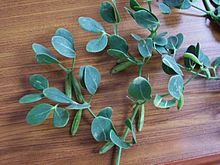Zygophyllum fabago
| Zygophyllum fabago | |
|---|---|

| |
| Scientific classification | |
| Kingdom: | Plantae |
| Clade: | Tracheophytes |
| Clade: | Angiosperms |
| Clade: | Eudicots |
| Clade: | Rosids |
| Order: | Zygophyllales |
| Family: | Zygophyllaceae |
| Genus: | Zygophyllum |
| Species: | Z. fabago
|
| Binomial name | |
| Zygophyllum fabago | |
Zygophyllum fabago is a species of plant known by the common name Syrian bean-caper. It is considered a noxious weed of economic importance in much of the western United States. It is native to Asia and East Europe (Russia and Ukraine) and Southeast Europe (Romania).[1]
Growth
[edit]The Syrian bean-caper grows long, thin stems with few oval-shaped, fleshy, waxy green leaflets each 2 to 3 centimeters in length. The flowers are small, compact bunches of five petals each with prominent stamens. The flowers have a taste and scent similar to caper. It grows in masses of individual plants, forming colonies, especially in dry, gravelly, saline, or disturbed areas where other plant life is rare.
Characteristics
[edit]The plant has invasive potential due to its long taproot which, even if fragmented, can produce a new plant, as well as the hardy wax coating on its leaves that tends to protect it from herbicides.
Chemical constituents
[edit]It contains about 0.002% harmine (entire plant).[2]
References
[edit]- ^ a b "Zygophyllum fabago". Germplasm Resources Information Network. Agricultural Research Service, United States Department of Agriculture. Retrieved 2008-04-30.
- ^ "Erowid Online Books : "Ayahuasca: alkaloids, plants, and analogs" by Keeper of the Trout". www.erowid.org. Retrieved 2008-04-30.
